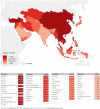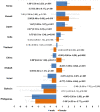Cancer Incidence and Mortality in Asian Countries: A Trend Analysis
- PMID: 35770775
- PMCID: PMC9252010
- DOI: 10.1177/10732748221095955
Cancer Incidence and Mortality in Asian Countries: A Trend Analysis
Abstract
Background: This study aimed to evaluate the updated burden and temporal trends of cancer incidence and mortality in Asian countries.
Methodology: The data used in this study were retrieved from the Global Cancer Observatory, Cancer Incidence in Five Continents volumes I-XI, and the World Health Organization mortality database. These data were used to calculate the Average Annual Percentage Change (AAPC), with a 95% confidence interval (CI) by joinpoint regression analysis to determine the epidemiological trend in the past decade.
Results: In 2020, the cancer incidence in Asia was 169.1 per 1 00 000, accounting for 49.3% of the global cancer incidence. The most common cancers included lung (13.8%), breast (10.8%) and colorectal (10.6%) cancers. Its mortality was 101.6 per 1 00 000 (58.3% of the global cancer death) with lung (19.2%), liver (10.5%) and stomach (9.9%) cancers being the most common causes of cancer death. The cancer incidence had been increasing in female population, with Korea (AAPC = 5.73, 95% CI [5.30, 6.17], P < .001), Japan (AAPC = 2.67, 95% CI [2.12, 3.23], P < .001) and Kuwait (AAPC = 2.08, 95% CI [.49, 3.69], P = .016) showing the most significant increases in the past decade. The incidence increase was also observed among population aged <40 years old, with Korea (female AAPC = 8.42, 95% CI [7.40, 9.45], P < .001; male AAPC = 5.28, 95% CI [4.23, 6.33], P <.001), China (female AAPC = 2.94, 95% CI [2.07, 3.81], P < .001; male AAPC = 1.37, 95% CI [.57, 2.18], P = .004) and Japan (female AAPC = 2.88, 95% CI [1.88, 3.88], P = .016; male AAPC = 1.59, 95% CI [.40, 2.78], P = .015) showing the most significant increases. However, there was an overall decreasing trend of cancer mortality.
Conclusions: There was a substantial burden of cancer incidence and mortality in Asia. Although there was a decreasing trend in cancer mortality, its incidence had been increasing especially among female and younger populations. Future studies could be done to further investigate the potential reasons for these epidemiologic trends.
Keywords: Cancer; Asian; incidence; mortality; disease budren; trend analysis; epidemiology; Average Annual Percentage Change.
Conflict of interest statement
Figures






References
-
- United Nations General Assembly . Political declaration of the third high-level meeting of the general assembly on the prevention and control of non-communicable diseases. http://www.un.org/en/ga/search/view_doc.asp?symbol=A/RES/73/2. Published October 17, 2018. Accessed August 6, 2021.
-
- United Nations . High level meeting on prevention and control of non-communicable diseases. http://www.un.org/en/ga/ncdmeeting2011/. Published September 16, 2011. Accessed August 6, 2021.
-
- World Health Organization . Global Action Plan for the Prevention and Control of NCDs 2013-2020. http://www.who.int/nmh/events/ncd_action_plan/en/. Published 2013. Accessed August 6, 2021.
-
- United Nations . Sustainable development goals: Knowledge platform. https://sustainabledevelopment.un.org/. Published January 2016. Accessed on August 6, 2021.
-
- United Nations . Population trends. https://asiapacific.unfpa.org/en/node/15207. Published January 2021. Accessed August 6, 2021.
MeSH terms
LinkOut - more resources
Full Text Sources
Medical
Miscellaneous

